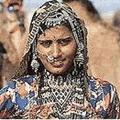 JAIPUR > Topics
JAIPUR > Topics

|
@himani07 | |
|
Celebrated usually during the first week of August, Teej festival is marked by rituals and fasts that accompany the monsoon clouds. The newly washed fields look fresh and beautiful and pea can often be spotted dancing during the season, as women sing Teej songs and enjoy rope swings in their gardens. Teej marks the beginning of the series of festivals and fairs that ends only with the Spring festival of Gangaur. Especially in Jaipur, Teej is celebrated with a special fervor and showers of rain on this day pep up the joyous celebrations by several degrees. It is considered a day for lovers and would-be life partners and young boys and girls come to the city from nearby villages, singing and dancing on bullock and camel carts and open tractor-trailers. The procession on Teej is the highlight of the festival. A festival especially for women, it is said that Teej commemorated the day when Goddess Parvati finally got married to Lord Shiva after severe penance of hundred years. Thus, women pray to Goddess for her blessings to gain marital bliss and long lives of their husbands. Women dress in all finery. Lehariya dresses are quite popular on this day and 'Ghewar' is the popular dessert of the day. Girls going to get married receive 'shrinjhara' from her in-laws on this day that consists of shringar (cosmetics), henna, lac bangles, lehariya saris (tie and dye fabric) and a sweet called ghewar. The women of the royalty can be distinguished by the special variety of laheria that they wear, known as 'Sanander', which is a pastel shade of blue. In the days of the princely rule, the royalty used to lead the ceremonial procession of Teej Mata in all its grandeur and royal splendor. Today, the Sawai Man Singh II Museum Trust and the Rajasthan Tourism Development Corporation undertake this task. The idol of Teej is freshly painted and adorned in rich finery and traditional jewelry. Then, the women of the royal family worship it. It is then taken to preside the procession mounted on the traditional palanquin 'Takht-e-rawan', where thousands of spectators and parti nts consisting of colorfully dressed villagers join it. It is led out by the 'Nishan ka hathi', the elephant with the flag from the Tripolia Gate. |
||
|
0
Replies
512
Views
0 Bookmarks
|
||
 JAIPUR Forum
JAIPUR Forum Bookmarks
Bookmarks JAIPUR
JAIPUR

 You are not logged in to Prodigits. Please
You are not logged in to Prodigits. Please 